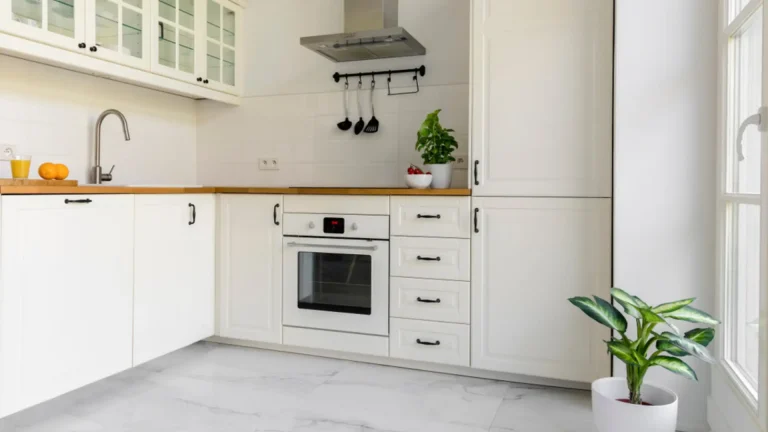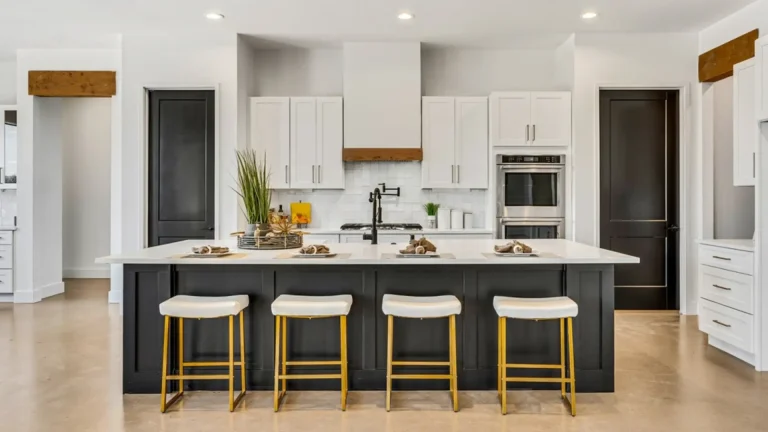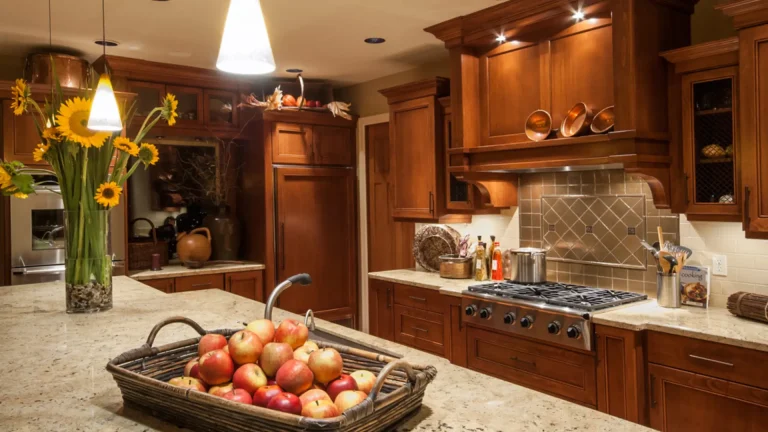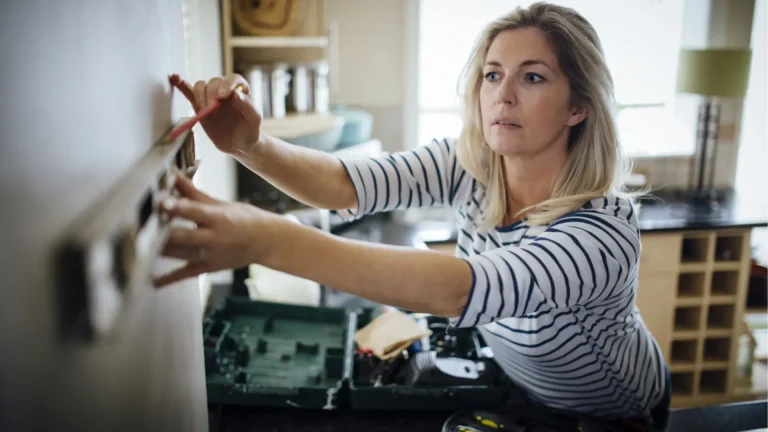Backsplash Ideas for Dark Cabinets: Enhancing Your Kitchen Aesthetics
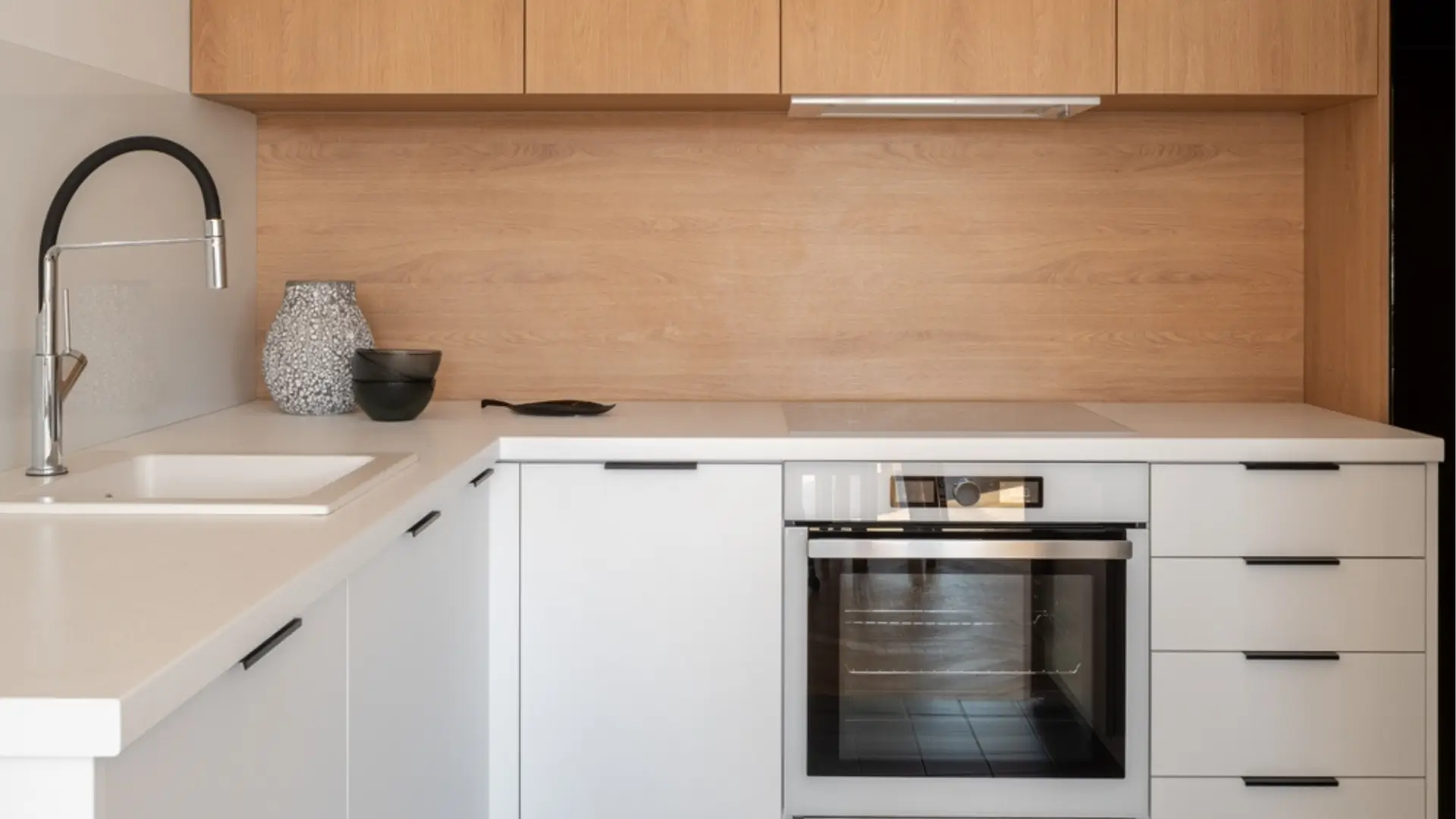
When it comes to designing a kitchen that’s both stylish and functional, choosing the right backsplash is crucial—especially if you’re working with dark cabinets. The perfect backsplash can illuminate and accentuate the elegance of dark cabinetry, creating a harmonious balance that elevates the entire space. In this guide, we’ll explore a variety of backsplash ideas for dark cabinets, offering inspiration and practical tips to help you achieve a kitchen that’s as beautiful as it is practical.
Importance of a Backsplash
A backsplash does more than just protect your walls from spills and splatters; it’s a key element of your kitchen’s design. For kitchens with dark cabinets, the backsplash serves as a focal point, bringing light and depth to the area. It’s an opportunity to inject creativity and personality into your kitchen, whether through color, texture, or material.
The Role of a Backsplash in Your Kitchen
Beyond its functional role, a backsplash is a canvas for aesthetic expression. In kitchens with dark cabinets, it plays a pivotal role in balancing light and shadow, adding brightness to areas that might otherwise feel too heavy or closed in. A thoughtfully chosen backsplash can also tie together the elements of your kitchen, creating a cohesive look that resonates with your personal style.
How Backsplash Complements Your Cabinets and Countertops
The right backsplash acts as a bridge between your cabinets and countertops, particularly in kitchens where there’s a stark contrast in tones. For dark cabinets paired with light countertops, the backsplash can soften transitions, harmonize disparate elements, and enhance the overall visual appeal of your kitchen.
What color backsplash goes with dark cabinets and light countertops?
Choosing the right color for your backsplash is essential when you have dark cabinets and light countertops. Lighter tones, such as whites or creams, can brighten the space and create a stunning contrast. Meanwhile, adding a splash of color with blues or greens can introduce vibrancy and character to your kitchen.
Factors to Consider When Choosing a Backsplash
Top 15 Backsplash Ideas for Dark Cabinets and Light Countertops
1) Bold Geometric Patterns
Geometric patterns bring a modern and dynamic flair to any kitchen, especially when juxtaposed with the solid, traditional look of dark cabinets. These patterns, whether in the form of hexagons, chevrons, or intricate mosaics, can transform a simple backsplash into a stunning focal point.
They offer a unique opportunity to inject personality and movement into the kitchen, drawing the eye and adding a layer of visual interest. For kitchens with minimalistic decor or sleek, contemporary lines, a geometric backsplash can serve as the artful centerpiece, bridging the gap between functionality and aesthetic appeal.
When selecting bold geometric patterns for your backsplash, consider the scale and color to ensure it complements rather than overwhelms your dark cabinets. Large, dramatic patterns can make a statement in spacious kitchens, while smaller, more subtle designs may be appropriate for compact spaces.
Opting for colors that contrast with your dark cabinets yet work harmoniously with your light countertops can create a balanced and inviting look. Metallic accents within geometric tiles can also add a touch of luxury and sophistication, enhancing the overall ambiance of your kitchen.
2) Glossy Grey Subway Tile
Glossy grey subway tiles offer a sleek and timeless backdrop that pairs beautifully with dark cabinets. The reflective surface of glossy tiles helps to bounce light around the room, making your kitchen appear brighter and more spacious.
The neutral grey tone provides a soft contrast to the dark wood, creating a sophisticated and cohesive look. This option is particularly appealing for those seeking a classic design that remains stylish over time, lending a clean and polished finish to your kitchen.
Incorporating glossy grey subway tiles also allows for versatility in decorating and styling your kitchen. These tiles can serve as a subtle base that supports bolder design elements, such as colorful appliances or vibrant kitchen accessories.
Alternatively, laying the tiles in an unexpected pattern, like a herringbone or vertical stack, can add a contemporary twist to the classic subway tile look. This flexibility makes glossy grey subway tiles an excellent choice for homeowners who appreciate both the beauty of dark cabinets and the timeless elegance of subway tile.
3) Marble Slab Backsplash
A marble slab backsplash is the epitome of luxury and elegance. Unlike tiled backsplashes, a single slab of marble offers a seamless and uninterrupted flow of natural beauty. The unique veining in marble can pull together the color palette of your kitchen, marrying the dark hues of the cabinets with the lighter tones of the countertops. This natural stone not only adds visual depth but also introduces an element of the natural world into your home, creating a calming and sophisticated environment.
Choosing a marble slab for your backsplash means selecting a piece of art. Each slab is unique, with its own patterns and color variations, ensuring that your kitchen will be one of a kind. It’s essential to consider the overall theme of your kitchen when selecting your marble, as the stone can range from subtle, with minimal veining, to dramatic, with bold, sweeping lines. A marble backsplash can also be a long-term investment, increasing the value of your home with its timeless appeal and durability.
4) Classic Subway Tiles
Classic subway tiles in white or light colors offer a crisp, clean look that brightens the kitchen and contrasts beautifully with dark cabinets. The simplicity of subway tiles allows the rich tones and textures of the cabinets to stand out, while the reflective surface of the tiles adds light and space to the kitchen environment.
This classic choice is versatile, working well in both traditional and modern kitchen designs, and provides a backdrop that can easily be accented with colorful decor or kept minimal for a more understated elegance.
Subway tiles also offer the opportunity for creativity through the use of different grout colors and laying patterns. A darker grout can create a striking graphic effect that outlines each tile, adding depth and interest to the backsplash.
Alternatively, laying the tiles in patterns such as herringbone or basketweave can introduce texture and movement, elevating the overall design. Despite their simplicity, subway tiles can be styled in countless ways, making them a timeless and adaptable choice for any kitchen.
5) Large White Picket Fence Backsplash
The large white picket fence tile design brings a charming and whimsical touch to the kitchen, offering a fresh and unique alternative to traditional backsplash options. This design features elongated, hexagonal tiles arranged in a way that mimics the look of a picket fence, providing a blend of cottage appeal and modern sophistication.
The white color reflects light, brightening the space and creating a striking contrast against dark cabinets. This distinctive shape and pattern add character and a sense of playfulness to the kitchen, making it a conversation starter and a focal point of the design.
When incorporating a large white picket fence backsplash, consider the balance of textures and colors in your kitchen. This backsplash works well in spaces that aim for a cozy, yet contemporary feel, bridging the gap between traditional charm and modern elegance.
Pairing this backsplash with simple, sleek hardware and light countertops can enhance its visual impact, creating a harmonious and inviting space. The unique pattern and shape of the tiles can also serve as inspiration for other design elements in the kitchen, from lighting fixtures to decorative accents, tying the entire room together with a cohesive theme.
6) Metallic Accents
Incorporating metallic accents into your backsplash offers a touch of glamour and sophistication, perfect for enhancing the luxurious feel of dark cabinets. Whether you choose copper, brass, stainless steel, or a brushed nickel finish, metallic tiles can reflect light and add a warm or cool glow to the kitchen, depending on the metal.
This option is particularly effective in kitchens with modern appliances and fixtures, creating a cohesive look that ties together the metallic elements throughout the space. Metallic tiles can be used as a full backsplash or as decorative accents within a more neutral design, providing flexibility in how bold or subtle you want the metallic influence to be.
Metallic accents are also versatile, able to fit into various design themes from industrial to contemporary chic. They can serve as a statement piece against dark wood cabinetry, especially when paired with under-cabinet lighting that highlights the metallic shimmer.
When choosing metallic tiles, consider the overall color scheme of your kitchen, including hardware and appliance finishes, to ensure a harmonious design that feels intentional and balanced.
7) Natural Stone Tiles
Natural stone tiles, such as slate, travertine, or limestone, bring an earthy, warm aesthetic to the kitchen, beautifully complementing the depth of dark cabinets. The natural variations in color, texture, and pattern of stone tiles add a unique, one-of-a-kind look to your backsplash, ensuring that no two kitchens will look exactly the same.
Stone tiles can range from rough and rustic to polished and refined, allowing you to choose a finish that aligns with your personal style and the overall design of your kitchen.
When incorporating natural stone tiles into your backsplash, consider the level of maintenance required, as some stones are more porous and may need to be sealed to prevent stains and damage. However, the natural beauty and timeless appeal of stone tiles make them a worthwhile investment, adding character and warmth to your kitchen that complements the solid presence of dark cabinetry.
8) A Light Textured Tile
Choosing a light textured tile for your backsplash can introduce depth and interest to your kitchen without overwhelming the space. Textured tiles, whether they’re embossed, beveled, or have a raised pattern, can catch the light and create shadow play, adding dimension to the kitchen. Light colors, such as off-white, light grey, or pale blue, can brighten the kitchen and make it feel more open, especially when contrasted with dark cabinets.
The texture of your tiles can echo elements in your kitchen or bring in new ones to add contrast. For instance, a backsplash with a subtle, organic texture can complement natural stone countertops, while a geometric textured tile might pair well with more modern, streamlined kitchen designs. Regardless of the specific texture, light textured tiles can bridge the gap between the dark cabinets and light countertops, creating a cohesive and visually appealing space.
9) Counter to Ceiling Boho Tile
Extending your backsplash from the countertop to the ceiling with boho-inspired tiles can make a bold and artistic statement in your kitchen. This design choice not only maximizes the impact of your backsplash but also elevates the overall aesthetic of the space, drawing the eye upward and making the room feel taller and more spacious. Boho tiles, known for their vibrant colors, intricate patterns, and eclectic designs, can introduce a playful and personalized touch to your kitchen, reflecting your unique style and preferences.
This approach works particularly well in kitchens with open shelving or minimal upper cabinets, as it provides a continuous, decorative backdrop for your kitchenware and decor. When selecting boho tiles, consider patterns and colors that complement the tones of your dark cabinets and light countertops, ensuring that the backsplash enhances rather than clashes with the existing elements in your kitchen.
10) Colorful Ceramic Tiles
Using colorful ceramic tiles for your backsplash is an excellent way to inject personality and vibrancy into your kitchen. Whether you opt for a single bold color, a mix of complementary hues, or a patterned design, colorful ceramic tiles can create a focal point and add character to the space. This option allows you to personalize your kitchen and make it truly unique, reflecting your taste and the mood you want to create. From deep blues and greens to bright yellows and reds, the possibilities are endless.
When incorporating colorful ceramic tiles with dark cabinets, consider the balance of color and the overall atmosphere you aim to achieve. A harmonious color scheme can unify the space, while a more contrasting palette can add drama and visual interest. Additionally, the glossy finish of ceramic tiles can help reflect light, brightening the space and making it feel more open and inviting.
11) A Rustic Brown Backsplash
A rustic brown backsplash, utilizing materials like terracotta tiles or reclaimed wood, adds warmth and character to kitchens with dark cabinets. This choice introduces a natural element that softens the boldness of dark cabinetry, creating a cozy, inviting atmosphere.
Terracotta tiles, with their natural earthy tones, bring a touch of Mediterranean or Southwestern charm, depending on their finish and shape. Reclaimed wood, on the other hand, adds texture and a story to your space, offering a contrast between the organic, lived-in feel of the wood and the sleek, modern appeal of dark cabinetry.
When incorporating a rustic brown backsplash, consider the overall theme of your kitchen. This style pairs well with natural stone countertops, copper accents, and open shelving, enhancing the rustic vibe. Maintaining a balance between rustic elements and modern conveniences ensures that your kitchen feels both welcoming and functional, a haven for both cooking and gathering.
12) Monochromatic Elegance
Opting for a monochromatic backsplash can create a sophisticated, cohesive look in a kitchen with dark cabinets. Using shades of black, gray, or even deep blues or greens, in a variety of textures and finishes, can add depth and interest to the space without introducing additional colors.
This approach is particularly effective in modern or minimalist kitchen designs, where the focus is on form and material rather than color. A monochromatic backsplash can range from matte black tiles that absorb light for a soft, elegant look to glossy finishes that reflect light, adding brightness and visual space.
A monochromatic palette emphasizes the sleek lines and design of your kitchen, creating a seamless transition between different surfaces. To prevent the space from feeling too flat or monotonous, mix materials and finishes—combine matte and glossy tiles, or introduce a subtle pattern or texture. This strategy adds layers to your kitchen’s design, making the monochromatic theme dynamic and visually interesting.
13) Neutral Greige Tile
Greige, a blend of gray and beige, is a versatile color choice that brings a sophisticated neutrality to kitchens. A greige tile backsplash provides a soft, subtle backdrop that complements both dark cabinets and light countertops. This color strikes a perfect balance, offering warmth without the yellow undertones of beige and a cooler, more modern feel than gray. Greige tiles can come in various finishes, from matte for a contemporary look to glossy for a more traditional kitchen style.
This neutral backdrop allows for flexibility in decorating, enabling accents and kitchenware to stand out. Greige works well with natural materials, such as wood and stone, and can serve as a unifying element in open-concept homes, tying the kitchen to adjoining living spaces. Its understated elegance makes it an ideal choice for those seeking a timeless look that can adapt to changing trends and personal tastes.
14) Moroccan Inspired Tiles
Moroccan-inspired tiles bring vibrant patterns and colors to the kitchen, adding a global, eclectic flair that pairs beautifully with the depth of dark cabinets. These tiles often feature intricate designs and a palette that can range from bold and colorful to subdued and earthy.
Installing a Moroccan-inspired backsplash is like adding a piece of art to your kitchen, one that tells a story and sparks conversation. The complex patterns can serve as a focal point, drawing the eye and adding a layer of visual interest that complements the solid colors of cabinetry and countertops.
When choosing Moroccan-inspired tiles, consider the scale of the pattern in relation to your kitchen’s size and the amount of natural light it receives. Larger, bolder patterns work well in spacious kitchens or as accent areas, while smaller, more delicate designs can suit compact spaces without overwhelming them. Pairing these tiles with simple, streamlined kitchen elements ensures that the backsplash remains the star of the show.
15) Wood Tile Backsplash
Wood tiles offer the warm look of wood with the durability and ease of maintenance of tile. A wood tile backsplash can introduce a natural, organic element into the kitchen, softening the contrast between dark cabinets and light countertops. This option is ideal for creating a rustic or Scandinavian-inspired kitchen, where the emphasis is on natural materials and a light, airy feel. Wood tiles come in a range of colors, finishes, and patterns, allowing for customization to fit your kitchen’s specific style.
Choosing a wood tile backsplash adds texture and warmth, inviting a sense of calm and comfort into the space. It works particularly well in kitchens that aim to blend modern and traditional elements, offering the charm of wood without the upkeep. Pairing wood tiles with minimalistic hardware and simple countertops can keep the focus on the beauty of the natural pattern, making your backsplash a standout feature of your kitchen design.
FAQs
Conclusion
Selecting the perfect backsplash for dark cabinets involves balancing color, texture, and material to create a cohesive and inviting space. Whether you’re drawn to the timeless elegance of marble, the rustic charm of natural stone, or the bold statement of geometric patterns, there’s a backsplash option to suit every style. Remember, the best choice reflects your personal taste and complements your kitchen’s overall design, making it a space you’ll love for years to come.


